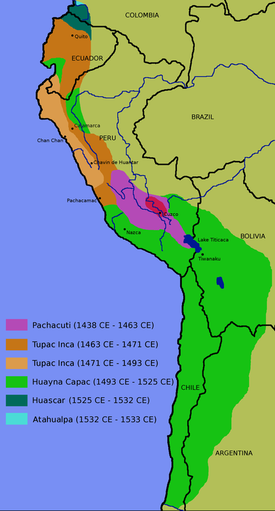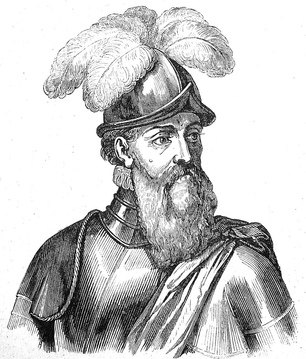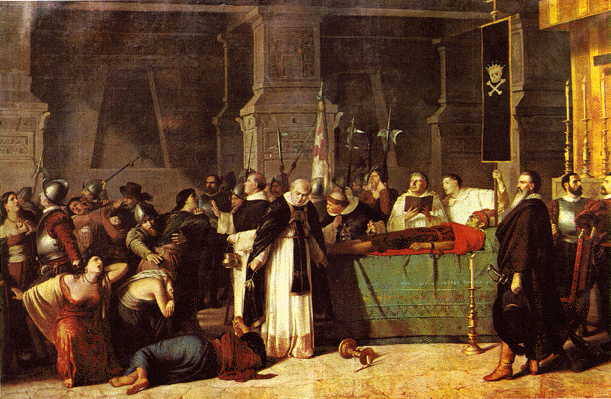BACKGROUND
|
The Inca Empire was the largest civilization in pre-Columbian America with an estimated population of over 16,000,000 at its height. The center of the Inca Empire which housed its administrative, political, and military center was located in Cusco in what is now modern-day Peru. However, the span of the Inca Empire could be traced from Ecuador all the way to Chile in what was considered the majority of Western South America (Chepstow-Lusty, A.J., et al). The rise of this empire is usually cited as the time in which the most flourishing occurred followed by its eventual collapse. For the Inca dates typically range from 1425-1533, thus signaling a rather short-lived reign (Spanish Conquest of the Inca Empire).
|
HUMAN IMPACT ON ENVIRONMENT
Although the Inca relied on agro forestry and heavy use of timber, there isn't much reliable information on whether their use was highly unsustainable and/or linked to collapse (Chepstow-Lusty and Jonsson). Interestingly though, over three millennia of mercury pollution was found in the Peruvian Andes. Intensive mercury mining began for the search a cinnabar, a mercury sulfide mineral that is very toxic but whose pigment was used to carve into jewelry and ornaments (Cooke, et al). After conquest by the Inca Empire, smelting was adopted at mines leading to greater bioaccumulation of Mercury throughout the environment. No reports have been found that link mercury exposure to the decline of the empire.
CLIMATE CHANGE
Climatic warming during Inca reign is said to have benefitted crop growth and the diffusion of agriculture across Inca territories. Pollen records sampled from different regions indicate that in spite of climatic changes, humans had molded the climate to varying degrees for the past 4,000 years. In the case of the Inca, exceptional biodiversity in crops (they had an estimated 70+ crops during their reign), may have led to greater resilience in the avoidance of famine (Chepstow-Lusty, et al).
RELATIONS WITH HOSTILE SOCIETIES
|
Relations with hostile societies, and in this case the Spanish, also pushed the Inca to the brink of collapse. When the Spanish first arrived to Inca lands they brought smallpox with them, a disease carried by cows. The Spanish, utilizing cows for centuries had built up immunity to the disease thus making them less susceptible to death unlike the Inca and Aztec (Crosby). After Pizarro had executed Atahualpa two more emperors were appointed until the last of the Inca blood line, Tupac Amaru, was sacked and executed in Cusco. Possibly due to high mortality rates from the smallpox pandemic and various social disruptions, the Inca Empire succumbed to a few hundred Spaniards.
|
RELATIONS WITH NEIGHBORING FRIENDLY SOCIETIES
The empire was notably led in 1528 by Huayna Capac whom contributed most to the expansion of the Inca Empire. Huayna Capac greatly relied on his eldest son to pass on his legacy but both had succumbed to death by smallpox in 1528. Since he died before electing a new heir, younger brothers Huascar and Atahualpa fought for the throne. Sparks soon erupted in a three-year war of succession to gain the throne (Inca Civil War) . Huascar claimed to be sole emperor or "Sapa Inca" over Cusco as he was directly blood related to Capac, but the army declared its loyalty to half brother Atahualpa resulting in a three-year war of succession from 1529-1532 that created vulnerabilities in the empire . The Empire was broken up into states with their own distinctive cultures making administration difficult since most word had to get across through foot or boat (Bauer, Brian, Covey) . Atahualpa eventually captured Huascar and killed him to become emperor, only to be killed in 1533 by Spanish conquistador Francisco Pizarro.
SOCIETY'S RESPONSE TO PROBLEMS
Economic tensions were mainly defined by the Spanish' search for Gold, God, and Glory at the cost of the Inca Empire. Perhaps this pertains to culture, but the Inca relied on weaponry that was far surpassed by the Spanish (double-edged clubs and bows and arrows vs. firearms and swords) which may have made them ever more susceptible to defeat (Andrushko, Valerie, Torres).
DOES DIAMOND'S FRAMEWORK APPLY TO THE INCA?
In terms of Diamond's model, environmental impacts and climate change do not seem to pose as viable factors for collapse with this specific civilization. Complementary to these findings, smallpox was cited as a major cause for decline by numerous scholars and yet it does not fall perfectly into any of the listed categories.
Photos used under Creative Commons from Biblioteca General Antonio Machado, Tomas Sobek



